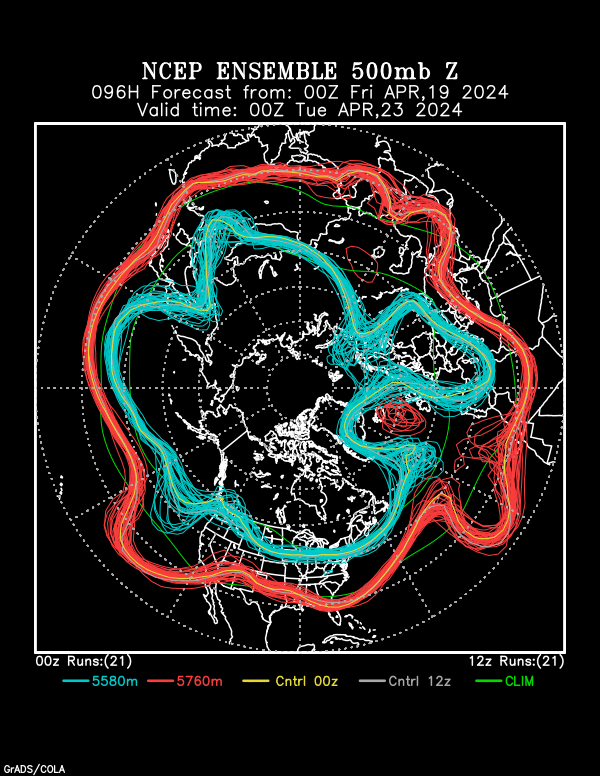the updated info goes like this:
2" or more (2-4") --- on the eastern side; Blacksburg VA, northeast to Allentown PA, Springfield MA, Gloucester MA, and out. On the western side, Blacksburg VA, to Pineville WV, then take that directly north to Cleveland.
4 Inches or more (4-8" area) --- on the eastern side, Union WV, northeast to Harrisburg PA, Pittsfield MA, Portland ME, and out. On the western side, Union WV to Johnstown PA, then northeast to Rochester NY. Local totals up to 10" cant be ruled out.
this WILL be a big ticket icing event in areas where the depth of the warm layer is such that p-type is predominantly ZRA (warm enough aloft for liquid, with a sub-freezing boundary layer). MDT, SEG, AVP, MPO, ABE, BGM LOOK OUT!!
significant ice accumulations on trees and power lines COULD result in outages across the piedmont areas from MD up through PA, and into southern new england.
overall i prefer the GFS solution over the ETA, but we will review both as the ETA does a better job with convective instability. that said the GFS generates QPFs of .50-.75" over a wide area of the interior MD/PA/NY/CT.

the big sticking point with this system is its fast movement. which will help to limit total QPF, and hence preclude what otherwise may have been a MAJOR ice and snow event for the interior Mid atlantic, northeast and new england. but even with this in mind, significant ice and snow is likely.
the ETA still implies good convective instability across much of the northern mid-atlantic. the 0z ETA sounding at ABE revealed strong elevated CAPE (generally less than 50 J/kg, however when dealing with CSI, it can be an important feature). as the strongest UVM moves over eastern PA/NJ and NYC between 42 and 48hrs as the trough tilts negative.


LR 5-7 are mostly dry adiabatic, generally between 6.50 and 7.00 C/km. and convective temps are reached.
KABE (allentown, PA) sounding:
http://weather.admin.niu.edu/chaser/tempgif/29280.TXT
KMPO (MT pocono PA) sounding:
http://weather.admin.niu.edu/chaser/tempgif/30237.TXT
KAVP (scranton/wilkes-barre PA) sounding:
http://weather.admin.niu.edu/chaser/tempgif/30306.TXT
the problems become even BIGGER once one gets into the AVP-BGM corridor. in this area, soundings show a near to ever so slightly above freezing layer below 800mb (evident mostly on the AVP sounding), thus im concerned that given the strong CI and CSI signals combined with this type of thermal profile that these areas will be back and forth between +SN/IP/ZRA. and im also concerned that P-type is mostly snow while the strongest UVM is overhead. thus somebody will probably pick up 8"+ especially across the higher elevations of the FAR northeastern poconos (central and northern wayne county for those that are familiar w/ NE PA)
now late week system --- im not going to worry about the specifics of the model output, since were 5 days out, making those aspects of the system irrelevant at this time (such as the track of SFC low, Ptype, QPF and so on).
tonights 0z GFS DOES attempt to take the irst system, close it off, and make it the new 50/50 low by 096hrs:

this (as i have said many times) forces the PJ wavelengths to sharpen, resulting in blocking over the top and therefore, a -NAO.
what therefore is most likely to happen is the s/w energy across the MS valley is going to be forced to take a more southern track, creating a colder and snowier solution for the Mid-atlantic and Northeast.
so even as the ridge pops up in western europe, which the ensembles illustrated quite well:

the teleconnection between that ridge and the ridge off the SE coast of the US is mitigated somewhat by the 50/50 low. and any blocking that might also try to develop. so, no, there WILL NOT be any major flood in the northeast this weekend.
overall IMO the event still has potential.
 The posts in this forum are NOT official forecast and should not be used as such. They are just the opinion of the poster and may or may not be backed by sound meteorological data. They are NOT endorsed by any professional institution or
The posts in this forum are NOT official forecast and should not be used as such. They are just the opinion of the poster and may or may not be backed by sound meteorological data. They are NOT endorsed by any professional institution or 







